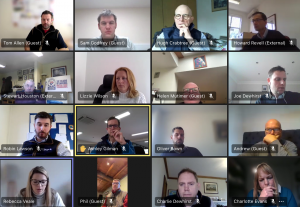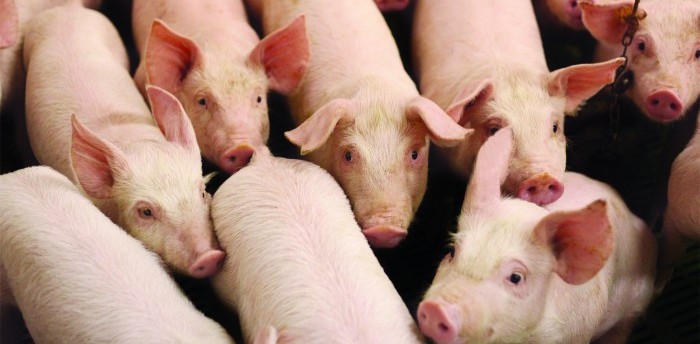The pig sector outlook is starting to feel a ‘little more positive’, but many producers continue to struggle financially and remain in dire straits, according to members of the NPA’s Pig Industry Group (PIG).
The PIG discussed the state of the industry on the ground during an online meeting on Tuesday. The biggest positive identified during the regional round-up was the easing of cereal prices, which have come down steadily in recent weeks – feed wheat is currently quoted by AHDB at £237/tonne for January, compared with a May high of in excess of £350/t.
However, PIG members pointed out that some producers who have bought feed ingredients forward at higher prices will not be feeling the benefit.
Other reasons for optimism included what appears to be a tightening of domestic supplies, alongside a recent rise in EU prices. But against that, while the SPP has remained steady at around £2/kg over the past few months, processor contribution prices have been steadily reduced cut over the past two weeks, putting fresh pressure on producers, many of which remain in an unsustainable financial position.
‘More positive’
 Kicking off the regional round-up, the NPA’s northern representative said: “Things are starting to feel a little bit more positive. People had been holding out for this shortage that wasn’t really materialising, but it feels like it’s now starting to start to appear, from what we’re hearing. It’s still fairly bleak, but there is a little bit of light at the end of the tunnel.”
Kicking off the regional round-up, the NPA’s northern representative said: “Things are starting to feel a little bit more positive. People had been holding out for this shortage that wasn’t really materialising, but it feels like it’s now starting to start to appear, from what we’re hearing. It’s still fairly bleak, but there is a little bit of light at the end of the tunnel.”
The eastern region representative agreed that ‘there is more positivity about’, with pigs moving more readily in the region, while seeing wheat prices coming back is also improving people’s mood. “But everyone is aware of what is happening with contribution prices and expecting a reduction in the SPP, which will negate any benefit from falling wheat prices,” he cautioned.
He delivered a positive summary on autumn drilling in the key arable region which he said would hopefully lead to a good harvest.
The south-central representative stressed, however, that there are ‘still quite a lot very depressed producers out there who are still losing considerable sums of money’. “So it is still concerning,” he said.
Another representative from the region added: “People are quite rightly very positive about the fact that cereals have come back, but it is equally important to point out that some people brought forward at much higher prices. Retailers and processors need to know that not everybody is going to be able to take advantage of the falling wheat price.”
The south-west representative highlighted some ‘cautious optimism’ among regional producers. “I know that a couple of producers have slipped into some fixed price contracts for their pigs which, coupled with the price they bought some of their wheat and barley at, is almost easing them towards a break-even situation.
“Pigs are moving – I haven’t had heard of any pigs being rolled and I am very pleased to see that the wheat price coming back to almost pre-Ukraine war levels. So, who knows, we might even be in the black next year.”
The Midlands representative said there appeared to be a shortage of production due to a combination of some health issues, the knock-on effect of the summer heat on fertility and producers going out of production.
“All of that has led to some of the smaller and medium-sized abattoirs in our region actively looking for extra pigs, which is not a position we have been in for a while, although the larger processors seem to be giving out more mixed signals and maybe have a bit better cover,” he said.
He reiterated the points made about the level of feed cover, pointing out that some producers were asked by their customers whether they had bought feed at lower prices when wheat prices were soaring to record highs. “So, I would expect the favour to now be returned,” he said.
Marketing perspective
The marketing group representative said cash flow issues were continuing to hurt many producers, while processor price reductions were a big concern.
But he added: “In the last few weeks, there is optimism that the European price is coming up, and weights have dropped, so hopefully people are in a better place and the focus is now on getting through the short weeks of Christmas and into the New Year.”
Positive feed update
There was a positive report from the feed sector representative, who highlighted how the opening of the grain corridor from Ukraine, allied with plentiful stocks being sold on the global market from Russia was easing the pressure on wheat prices. But she reinforced the point made earlier that how some customers were not seeing the benefits as they had bought forward at considerably higher prices.
Meanwhile, soya prices remain high at around £470-£480/t, with much depending on what happens in China and the weather in South America.
Unsurprisingly, the buildings and equipment sector remains ‘relatively quiet’, with energy costs a big factor, but, according to the representative from that sector, this is also providing an opportunity to get some key messages out there about energy efficiency.




